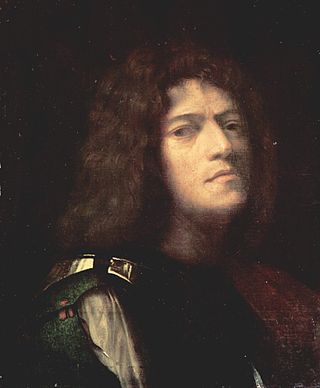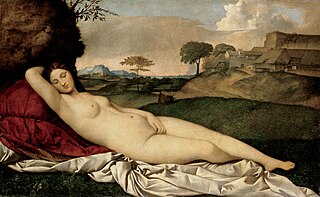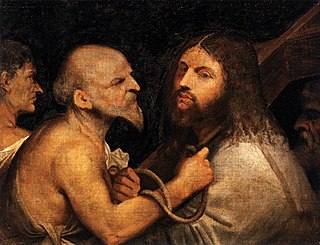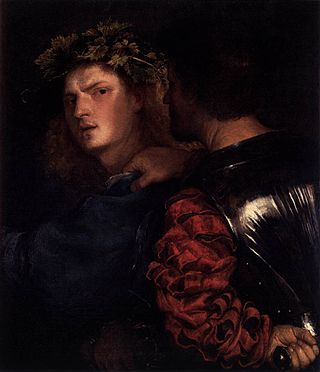
Giorgione was an Italian painter of the Venetian school during the High Renaissance, who died in his thirties. He is known for the elusive poetic quality of his work, though only about six surviving paintings are firmly attributed to him. The uncertainty surrounding the identity and meaning of his work has made Giorgione one of the most mysterious figures in European art.

Tiziano Vecelli or Vecellio, known in English as Titian, was an Italian (Venetian) painter of the Renaissance, considered the most important member of the 16th-century Venetian school. He was born in Pieve di Cadore, near Belluno. During his lifetime he was often called da Cadore, 'from Cadore', taken from his native region.

The Alte Pinakothek is an art museum located in the Kunstareal area in Munich, Germany. It is one of the oldest galleries in the world and houses a significant collection of Old Master paintings. The name Alte (Old) Pinakothek refers to the time period covered by the collection—from the fourteenth to the eighteenth century. The Neue Pinakothek, re-built in 1981, covers nineteenth-century art, and Pinakothek der Moderne, opened in 2002, exhibits modern art. All three galleries are part of the Bavarian State Painting Collections, an organization of the Free state of Bavaria.

The Neue Pinakothek is an art museum in Munich, Germany. Its focus is European Art of the 18th and 19th centuries, and it is one of the most important museums of art of the nineteenth century in the world.

The Gemäldegalerie Alte Meister in Dresden, Germany, displays around 750 paintings from the 15th to the 18th centuries. It includes major Italian Renaissance works as well as Dutch and Flemish paintings. Outstanding works by German, French, and Spanish painters of the period are also among the gallery's attractions.

The Sleeping Venus, also known as the Dresden Venus, is a painting traditionally attributed to the Italian Renaissance painter Giorgione, although it has long been usually thought that Titian completed it after Giorgione's death in 1510. The landscape and sky are generally accepted to be mainly by Titian. In the 21st century, much scholarly opinion has shifted further, to see the nude figure of Venus as also painted by Titian, leaving Giorgione's contribution uncertain. It is in the Gemäldegalerie, Dresden. After World War II, the painting was briefly in possession of the Soviet Union.

La Schiavona, also known as Portrait of a Lady, is a 1510–1512 portrait by Titian of an unknown woman.

Venetian painting was a major force in Italian Renaissance painting and beyond. Beginning with the work of Giovanni Bellini and his brother Gentile Bellini and their workshops, the major artists of the Venetian school included Giorgione, Titian, Tintoretto (1518–1594), Paolo Veronese (1528–1588) and Jacopo Bassano (1510–1592) and his sons. Considered to give primacy to colour over line, the tradition of the Venetian school contrasted with the Mannerism prevalent in the rest of Italy. The Venetian style exerted great influence upon the subsequent development of Western painting.

Christ Carrying the Cross is an oil painting attributed to either Titian or Giorgione. It is dated to about 1505. The painting is housed in the Scuola Grande di San Rocco in Venice, Italy. There are several later versions of the subject by Titian.

The Apparition of Christ to the Virgin is a painting by the Italian Renaissance master Filippino Lippi, executed around 1493 and now housed in the Alte Pinakothek of Munich, Germany.

The Portrait of Charles V is an oil on canvas portrait of Charles V, Holy Roman Emperor by Titian, painted in 1548. As with the Equestrian Portrait of Charles V, it was commissioned by Charles during Titian's stay at the imperial court at Augsburg. It is now in the Alte Pinakothek in Munich, Germany.

Violante is an oil painting attributed to Titian, dated to around 1515 and now held at the Kunsthistorisches Museum in Vienna.

Flora is an oil painting by Italian late Renaissance painter Titian, dated to around 1515 and now held at the Uffizi Gallery in Florence.

Woman with a Mirror is a painting by Titian, dated to c. 1515 and now in the Musée du Louvre, in Paris.

The Crowning with Thorns or Christ Crowned with Thorns is an oil on canvas painting by Titian, executed in 1576, now in the Alte Pinakothek in Munich. It is a typical composition from his final period. and can be compared with an earlier 1542 work of his on the same subject.

The Bravo is an oil painting usually attributed to Titian, dated to around 1516-17 and now in the Kunsthistorisches Museum in Vienna. The painting can be seen as one of a number of Venetian paintings of the 1510s showing two or three half-length figures with heads close together, often with their expressions and interactions enigmatic. Most of these are "Giorgionesque" genre or tronie subjects where the subjects are anonymous, though the group includes Titian's The Tribute Money, with Christ as the main figure, which in terms of style is similar to this painting, and his Lucretia and her Husband, also in Vienna, where at least the woman's identity is clear, if not that of the man.

Portrait of a Knight of Malta is a c.1515 oil on canvas painting by Titian of a knight belonging to the Order of Malta. It is now in the Uffizi in Florence. The last bead of the rosary held by the knight bears the number XXXV (35), showing the subject's age at the time of the portrait. W.F. Dickes. argued that he was Stefano Colonna, the condottiero who led the republican resistance during the siege of Florence. cited in

The Pastoral Concert or Le Concert Champêtre is an oil painting of c. 1509 attributed to the Italian Renaissance master Titian. It was previously attributed to his fellow Venetian and contemporary Giorgione. It is now in the Musée du Louvre in Paris.
The Muselli collection was one of the most notable art collections in 18th century Italy and - with the Gusti and Curtoni collections - a highlight of modern collecting in Verona.

Madonna and Child with Three Saints or Adoration of the Christ Child with Saints is a c.1519 oil on canvas painting by Titian, now in the Alte Pinakothek in Munich.. From left to right the adoring saints are Francis of Assisi, Jerome and Anthony Abbot.



















